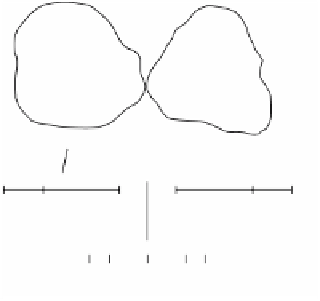Graphics Reference
In-Depth Information
7.4
Homotopy Theory
7.4.1
The Fundamental Group
We motivated homology theory by saying that it was an attempt to analyze the “holes”
in a space. For homology theory “holes” were treated algebraically, but we pointed
out at the time that the more natural classification of holes would be via homotopy
theory. We shall now take up this homotopy approach, beginning with the one-dimen-
sional “holes” or closed paths. By studying the number of homotopy classes of closed
paths we shall arrive at another important invariant associated to a topological space.
However, rather than studying maps of the circle it is convenient to use maps of an
interval where both end points are mapped to the same point because this simplifies
a number of formulas. Such maps are clearly equivalent to maps of a circle. Through-
out this section
I
will, as usual, denote the unit interval [0,1].
Let
X
be a pointed topological space with base point
x
0
. We define a composition
or “product” of closed paths in
X
.
Definition.
Given maps a, b :(
I
,∂
I
) Æ (
X
,
x
0
) define a map a*b:(
I
,∂
I
) Æ (
X
,
x
0
) by
1
2
(
)( )
=
()
ab
*
t
a
2
t
,
if
0
££
t
,
1
2
(
)
=-
b
21
t
,
if
££
t
1
.
See Figure 7.16. If one thinks of a and b as describing paths that one walks along,
then a*b corresponds to first walking along a at twice the original speed and then
along b, also at twice the speed. The next four lemmas lead up to the main result,
which is Theorem 7.4.1.5.
7.4.1.1. Lemma.
Let a, a¢, b, b¢ :(
I
,∂
I
) Æ (
X
,
x
0
). If a
∂
I
a¢ and b
∂
I
b¢, then a*b
∂
I
a¢*b¢.
Proof.
If f(t,s) and g(t,s) are homotopies between a, a¢ and b, b¢, respectively, then
the map
b(2s-1)
a(2t)
a(0) = a(1)
b(0) = b(1)
a
b
a*b
0
2t
1
0
2s-1
1
Figure 7.16.
The composition of closed paths.
0t
1/2
s
1










